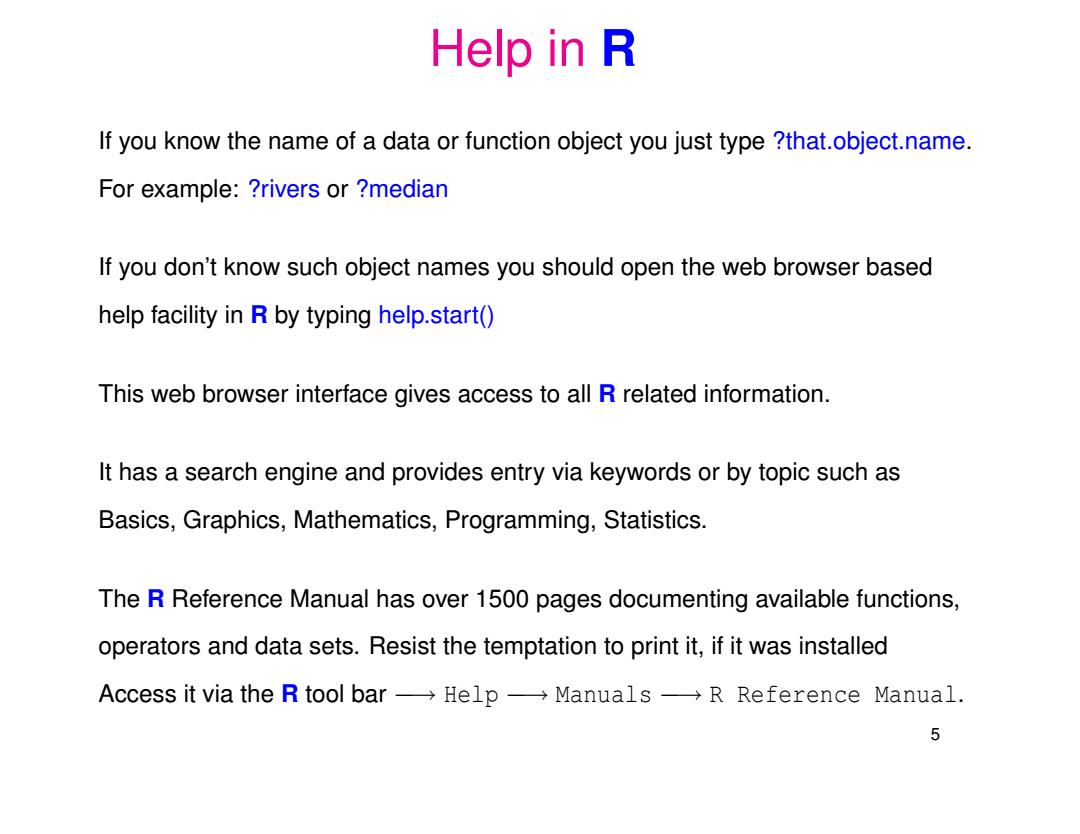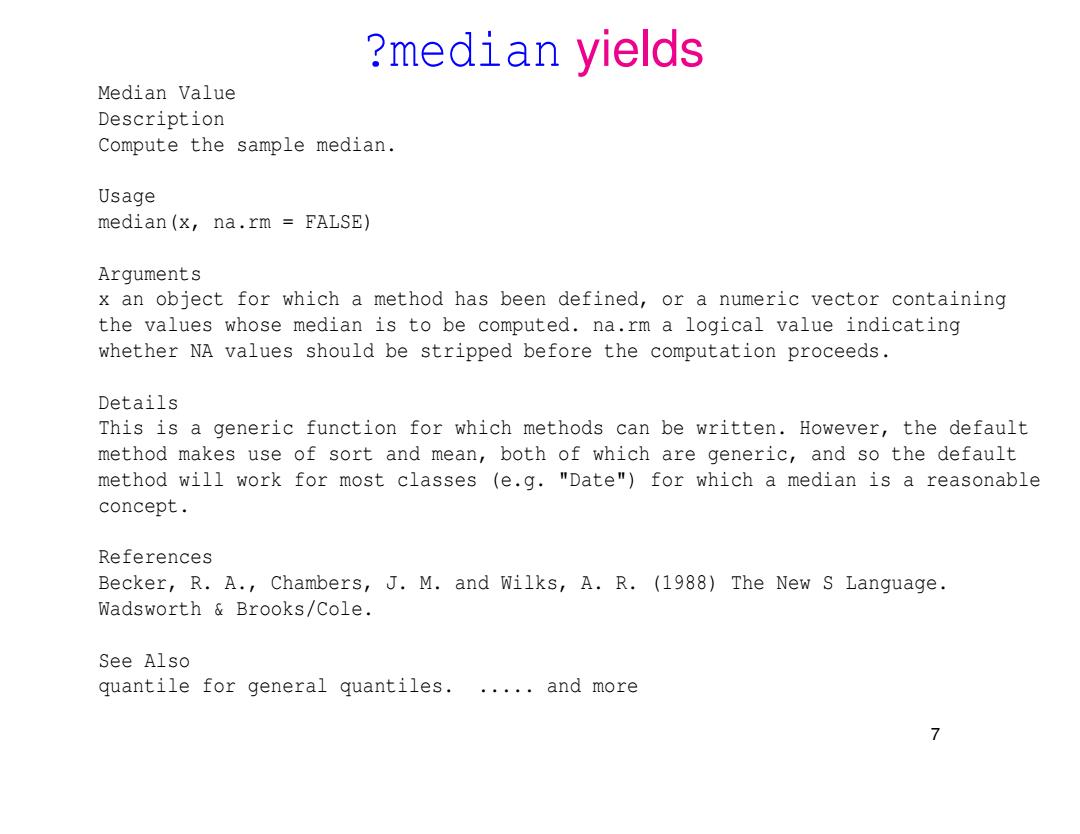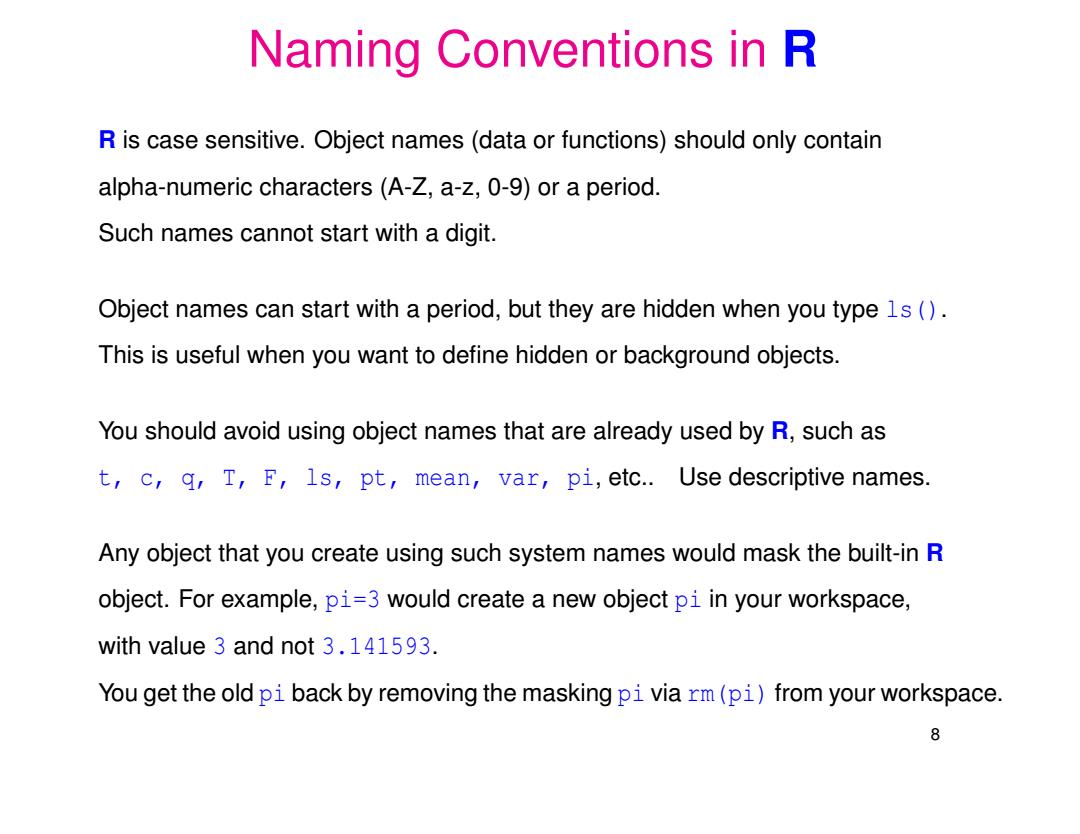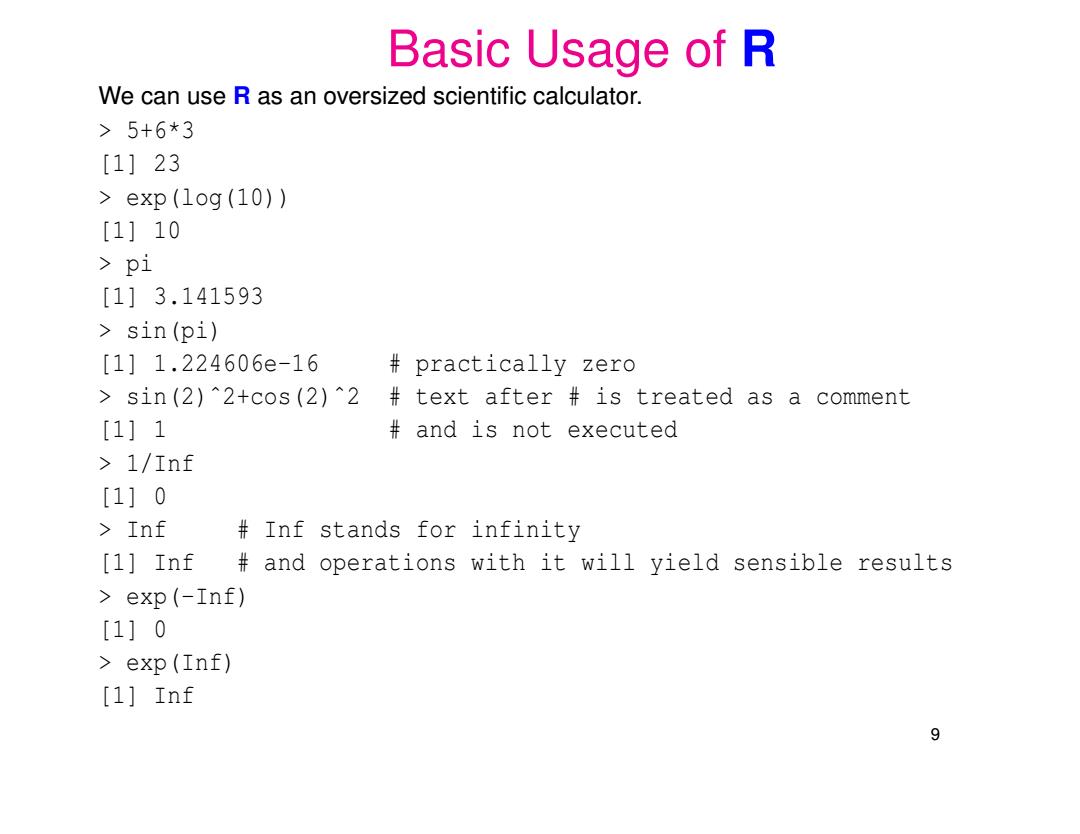
Help in R If you know the name of a data or function object you just type ?that.object.name. For example:?rivers or ?median If you don't know such object names you should open the web browser based help facility in R by typing help.start() This web browser interface gives access to all R related information. It has a search engine and provides entry via keywords or by topic such as Basics,Graphics,Mathematics,Programming,Statistics. The R Reference Manual has over 1500 pages documenting available functions, operators and data sets.Resist the temptation to print it,if it was installed Access it via the R tool bar→Help→Manuals→R Reference Manual. 5
Help in R If you know the name of a data or function object you just type ?that.object.name. For example: ?rivers or ?median If you don’t know such object names you should open the web browser based help facility in R by typing help.start() This web browser interface gives access to all R related information. It has a search engine and provides entry via keywords or by topic such as Basics, Graphics, Mathematics, Programming, Statistics. The R Reference Manual has over 1500 pages documenting available functions, operators and data sets. Resist the temptation to print it, if it was installed Access it via the R tool bar −→ Help −→ Manuals −→ R Reference Manual. 5

?rivers yields rivers(datasets)R Documentation Lengths of Major North American Rivers Description This data set gives the lengths (in miles)of 141 major rivers in North America,as compiled by the US Geological Survey. Usage rivers Format A vector containing 141 observations. Source World Almanac and Book of Facts,1975,page 406. References McNeil,D.R.(1977)Interactive Data Analysis.New York:Wiley. 6
?rivers yields rivers(datasets) R Documentation Lengths of Major North American Rivers Description This data set gives the lengths (in miles) of 141 major rivers in North America, as compiled by the US Geological Survey. Usage rivers Format A vector containing 141 observations. Source World Almanac and Book of Facts, 1975, page 406. References McNeil, D. R. (1977) Interactive Data Analysis. New York: Wiley. 6

?median yields Median Value Description Compute the sample median. Usage median(x,na.rm FALSE) Arquments x an object for which a method has been defined,or a numeric vector containing the values whose median is to be computed.na.rm a logical value indicating whether NA values should be stripped before the computation proceeds. Details This is a generic function for which methods can be written.However,the default method makes use of sort and mean,both of which are generic,and so the default method will work for most classes (e.g."Date")for which a median is a reasonable concept. References Becker,R.A.,Chambers,J.M.and Wilks,A.R.(1988)The New S Language. Wadsworth Brooks/Cole. See Also quantile for general quantiles......and more 7
?median yields Median Value Description Compute the sample median. Usage median(x, na.rm = FALSE) Arguments x an object for which a method has been defined, or a numeric vector containing the values whose median is to be computed. na.rm a logical value indicating whether NA values should be stripped before the computation proceeds. Details This is a generic function for which methods can be written. However, the default method makes use of sort and mean, both of which are generic, and so the default method will work for most classes (e.g. "Date") for which a median is a reasonable concept. References Becker, R. A., Chambers, J. M. and Wilks, A. R. (1988) The New S Language. Wadsworth & Brooks/Cole. See Also quantile for general quantiles. ..... and more 7

Naming Conventions in R R is case sensitive.Object names(data or functions)should only contain alpha-numeric characters (A-Z,a-z,0-9)or a period. Such names cannot start with a digit. Object names can start with a period,but they are hidden when you type 1s(). This is useful when you want to define hidden or background objects. You should avoid using object names that are already used by R,such as t,c,q,T,F,1s,pt,mean,var,pi,etc..Use descriptive names. Any object that you create using such system names would mask the built-in R object.For example,pi=3 would create a new object pi in your workspace, with value 3 and not 3.141593. You get the old pi back by removing the masking pi via rm(pi)from your workspace. 8
Naming Conventions in R R is case sensitive. Object names (data or functions) should only contain alpha-numeric characters (A-Z, a-z, 0-9) or a period. Such names cannot start with a digit. Object names can start with a period, but they are hidden when you type ls(). This is useful when you want to define hidden or background objects. You should avoid using object names that are already used by R, such as t, c, q, T, F, ls, pt, mean, var, pi, etc.. Use descriptive names. Any object that you create using such system names would mask the built-in R object. For example, pi=3 would create a new object pi in your workspace, with value 3 and not 3.141593. You get the old pi back by removing the masking pi via rm(pi) from your workspace. 8

Basic Usage of R We can use R as an oversized scientific calculator. >5+6*3 [1]23 >exp(1og(10)) [1]10 pi [1]3.141593 sin(pi) [1]1.224606e-16 practically zero sin(2)2+cos(2)2 text after is treated as a comment [1]1 and is not executed 1/Inf [1]0 Inf Inf stands for infinity [1]Inf and operations with it will yield sensible results exp(-Inf) [1]0 exp(Inf) [1]Inf 9
Basic Usage of R We can use R as an oversized scientific calculator. > 5+6*3 [1] 23 > exp(log(10)) [1] 10 > pi [1] 3.141593 > sin(pi) [1] 1.224606e-16 # practically zero > sin(2)ˆ2+cos(2)ˆ2 # text after # is treated as a comment [1] 1 # and is not executed > 1/Inf [1] 0 > Inf # Inf stands for infinity [1] Inf # and operations with it will yield sensible results > exp(-Inf) [1] 0 > exp(Inf) [1] Inf 9